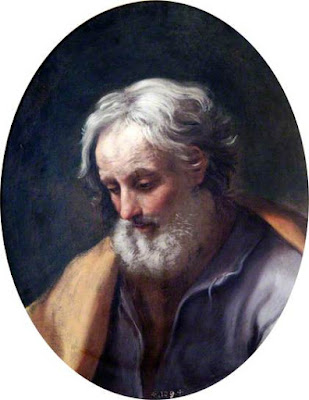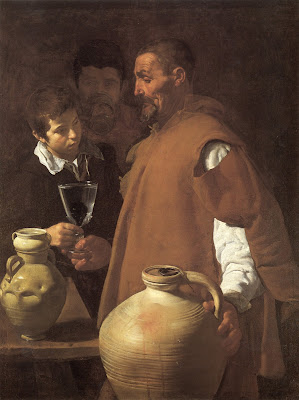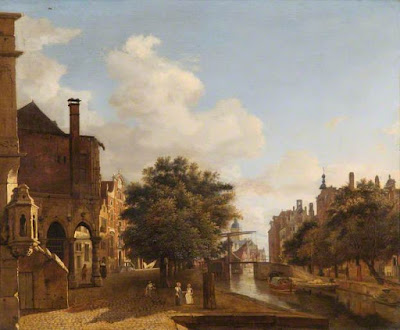Apsley House, as you may have gathered from our other pictures, is full of artwork. Under the care of English Heritage are the many sculptures, portraits, old masters, and a few contemporary works.
In the Waterloo Gallery; above the mantel, Queen Mary Tudor, after Antonio Moro;
frame designed by Wyatt and made by Thomas Temple and Son, about 1830
In the Drawing Rooms
After his victory at Waterloo, the Duke of Wellington purchased Apsley House in 1817 from his elder brother, Richard, Marquess Wellesley, who had lived there since 1807. Several years later, Wellington had architect Benjamin Dean Wyatt remodel several rooms to enhance his aim to use the London mansion to entertain as well as to house his collections.
Though the largest number of paintings in the collection come from Madrid, several were presented to Wellington in 1812 by the Intendant of Segovia in gratitude and recognition of his service to Spain in the Peninsular War. Although most of these paintings are elsewhere, several hang at Apsley House.
Head of St Joseph, by Guido Reni (1575-1642)
After the Battle of Vitoria, in Spain just 85 miles from the French border, in June, 1813, Wellington’s troops captured the baggage train of King Joseph, the brother Napoleon had appointed puppet king of Spain. Joseph was attempting to take looted paintings from the Royal Spanish Collection to the Louvre in Paris, and in fact he managed to escape with about a dozen. The canvases had been removed from their frames and rolled up, and dozens were found in wagons among manuscripts, ancient books, and other booty.
Entering the Ark by Jan Brueghel the Elder (1568-1625)
These captured works were sent to London where Wellington asked his brother William Wellesley- Pole to have them assessed for damage and value. Once the rightful King, Ferdinand VII, was restored to the Spanish throne, Wellington tried to have the paintings sent back to Madrid. However, the King was so grateful to the British, he urged the Duke to keep them, which, after first declining, the Duke eventually agreed to do.
Agony in the Garden, by Antonio Allegri, called Correggio. c. 1525
The Last Supper, with the institution of the Eucharist and Christ washing the Disciple’s feet, workshop of Juan de Flandes, active 1490’s), one of a series of small panels belonging to Queen Isabella of Spain, d. 1504; probably the oldest paining in the collection.
Not all of the paintings have a religious theme.
The Waterseller of Seville by Diego Velasquez, C. 1620
Battle Scene with Classical Colonnade by Salvator Rosa (1615-1773)
More than eighty of the paintings from the Spajish Royal Collection now hang at Apsley House and most of them can be traced to their acquisition by various Spanish monarchs. Recent cleaning and research on paintings formerly identified as being from the studio or followers of Titian were recently confirmed to be by the master himself, Tiziano Vercellio, c. 1482-1576
.
English Heritage restorer works on Titian’s Mistress, now cleaned and verified
as an actual Titian work
Titan’s Mistress
The 1st Duke of Wellington purchased paintings at sales in Paris after the war and at several sales of Dutch paintings; While active in politics, he did not buy often, but later, again turned to collecting art in the 1840’s.
Dutch landscapes have long been favorites of English nobles.
Architectural Fantasy with the Old Town Hall, Amsterdam
by Jan van der Heyden (1666-1699)
Some paintings were commissioned by the 1st Duke.
Chelsea Pensioners Reading the Waterloo Dispatch
by Sir David Wilkie, RA (1785-1841)
Read more about this painting here. The reported price of the painting was 1200 Guineas. The portrait below by Wilkie of King William IV, formerly Prince William, Duke of Clarence, was presented to the Duke by the King
King William IV, by Sir David Wilkie, RA, 1833
The 1st Duke also commissioned a painting by Sir Edwin Henry Landseer in 1826, finished three years later in 1829. It was exhibited at the Royal Academy and elsewhere. Its cost was 350 pounds. The Duke was said to be very pleased with the work.
The Illicit Highland Still, by Sir Edwin Henry Landseer, RA,1829
As any visitor would expect, many of the artworks in the Wellington Museum collection relate to the 1st Duke’s career, his associates, and his victory in the Battle of Waterloo.
The Battle of Waterloo, 1815, by Sir William Allen, 1843
Allen’s panoramic painting shows the view from the French side of the battle, about 7:30 pm, “the last desperate attempt of Napoleon (seen on the right) to force the left centre of the allied army and turn their position. The Duke of Wellington is on the left. He reportedly said of the painting, “Good, – very good; not too much smoke.”
Many of the paintings are full length originals or copies by Beechey, Lawrence, and other leading portraitists of the early 19th Century. One example is below.
Henry William Paget,(176-1854) 1st Marquess of Anglesey KG
by Sir Thomas Lawrence, RA. 1818
The 1sr Duke purchased some of the oil sketches of Jan Pieneman, who created a huge painting of The Battle of Waterloo, the largest such work in Amsterdam’s Rijksmueum.
The Battle of Waterloo bu Jan Pieneman, Rijksmuseum; shows Wellington on horseback in center; the wounded Prince of Orange on the lower left.
The oil sketches below are just two of the many the Duke acquired. Pieneman created these works in the early 1820’s as life studies for his large painting, finished in 1824. It is on permanent loan from the Dutch Royal Collection to the Rijksmuseum. Some of the oil sketches hang at Apsley House.
Major General the Hon;Sir Frederick Cavendish Ponsonby (18783-1837)
above and left: Major General Sir Colin Campbell (1776-1847)
General Sir Colin Halkett, (1774-1856)
The Duke did not avoid pictures of the French. Napoleon and his first wife Josephine re on display, as well as a portrait of Pauline Bonaparte, Princess Borghese. In 1814 the Duke of Wellington purchased Pauline’s mansion in Paris on behalf of the British Government, It is still the Embassy of the United Kingdom in France.
Napoleon Bonaparte by Robert Lefevre (1755-1830)
The Empress Josephine by Lefevre
Pauline Bonaparte by Lefevre
Van Dyke’s Charles I, with an unfortunate reflection (not a flash)
hanging in the Waterloo Gallery
Charles I on Horseback, after Anthony Van Dyke
The original is in Buckingham Palace;
another version is in Highclere Castle which our tour will see soon
Bust of Napoleon by Canova
The Duke of Wellington Looking at the Bust of Napoleon
by Charles Robert Leslie, RA (1794-1859)
Victoria, Kristine and Diane Perkins pose with the Duke
The 1st Duke of Wellington (1769–1852)
copy after Thomas Lawrence by Spiridione Gambardella, 1860
This is a copy of the painting above, but with an added cape and spyglass.
This post covers a fraction of the fantastic collection at Apsley House, The Wellington Museum. Be sure you put it on your agenda for your next London visit!
























Thank you. The art is quite fabulous and a joy to see.
I guess if he can have Napoleon he didn't quibble about Anglesey–
Talk about the spoils of war! What a glorious collection. Definitely on my bucket list to see.
Lovely! Thanks for sharing… Ah, my daughter took the 3-year wall painting restoration course at the Courtauld, not the 2-year easel painting course…or else, she might have been the English Heritage restorer in your photo! (She still works for English Heritage;they hired her right out of the Courtauld.)